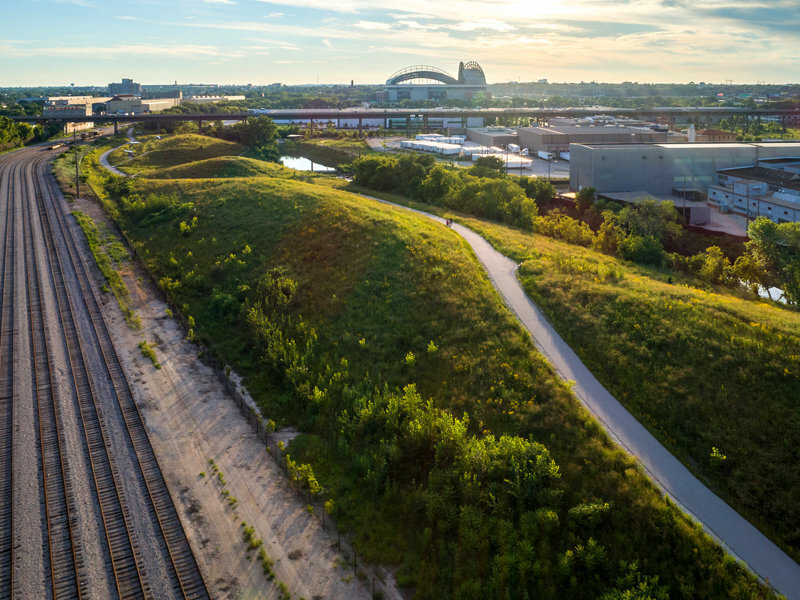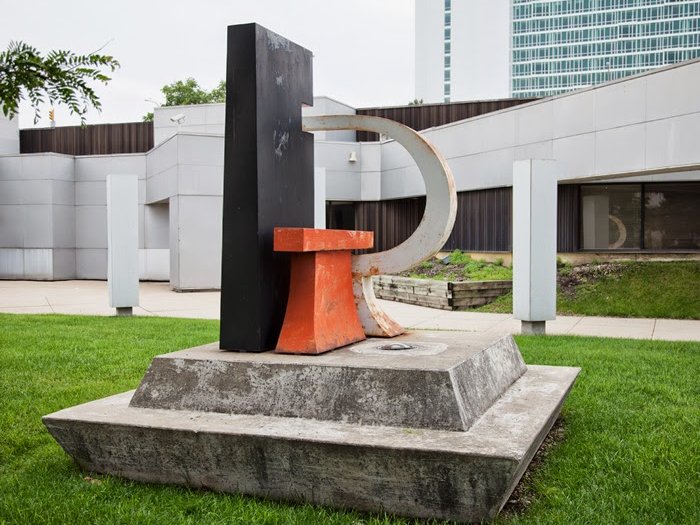You’re not mistaken: those drumlins, kames and eskers were not always down there in the Menomonee Valley.
No, the mounds you see are the foundations of the new Three Bridges Park, which stretches from Mitchell Park on the east to the Urban Ecology Center at 37th Street on the west.
The 24-acre green space, with lots of river access and plenty of rolling hills – man-made rolling hills – is due to open on July 20. The park is a facet of "Menomonee Valley – From the Ground Up," a series of interconnected projects that, according to Menomonee Valley Partners, aims "to improve access to jobs, environmental education, outdoor recreation and neighborhood vitality."
Ninety percent of the $25 million required for the project has been raised and on-site, the progress is clear. Alfred Benesch & Co. was the project's lead design firm, and engineer Bill Zippel has played a key role.
"When the Marquette Interchange was being done they brought in 75,000 truckloads of fill that raised this whole site out of the floodplain to build, but it also made mounds everywhere," says Corey Zetts, associate director of Menomonee Valley Partners, Inc., as she gives me a tour of the sprawling site. The area offers great views of the Domes, Potawatomi Bingo Casino, Miller Park, the Downtown skyline and, of course, the Menomonee River, which delineates the northern edge of the park.
"That enabled us to make bridges that crossed from this (south) side, which is really far below Mitchell Park and cross back into the Silver City neighborhood."
Visitors can enter the park from the bridge that connects to Mitchell Park behind the Domes and make their way to the Urban Ecology Center and up into the South Side neighborhood. Or they can cross over the river at 37th Street and continue on the Hank Aaron State Trail toward Miller Park.
This stretch is a major upgrade for the trail, which previously followed Canal Street through this section of the Menomonee Valley.
But the park isn’t simply a means of getting from here to there. The site will be planted with native species and the fill has helped remediate a former brownfield. There will be boat launches and fishing piers, trails for hiking and biking, as well as community gardens.
The park is part of a 160-acre parcel in the Valley that is owned by the city. Sixty acres is home to industry, 60 more to parkland and the rest is roads and utilities. On that first 60 acres are more than a half-dozen new businesses and 1,200 jobs, says Zetts.
"In 2002 when the city took ownership of the old Milwaukee Road site, there was a national design competition for the site and it really looked at how to retain manufacturing family supporting jobs but also to create public access to the Menomonee River and create some green space for a neighborhood that’s pretty under-served," she says.
"It’s been a process of getting all the pieces in place. The easiest place to start was the business development site."
Next was the creation of the Urban Ecology Center, which is located in a renovated tavern up on Pierce Street, just above the west end of the site. There, school groups visit to learn about wildlife, nature, ecology and the outdoors. There are also fishing poles, snow shoes and other equipment that visitors can use. A few doors east is the Wisconsin Bike Federation.
Just below is one of the three bridges for which the park is named.
"This was the first and most important bridge to reconnect the neighborhood as jobs were coming back, and for public access to the river," Zetts says. "This was really a walk and bike to work bridge."
Folks who live just across the river from the companies where they work could see their workplaces right out their window but without the bridge, it was a two-mile commute, as they’d loop east to 16th Street or west to Highway 41.
Next up was the UEC.
"It’s kind of cool that it’s always been a way station for the neighborhood (as a tavern and rooming house for railroad workers) and it still is a different kind of way station for the neighborhood," says Zetts.
Now, it’s time for the hills to shine. And those hills, says Zetts, will be educational.
"We knew that we would shape all these hills of dirt to have the Hank Aaron State Trail run through here and connect. As we got into designing, we thought that if we’re moving all this dirt anyway, we may as well try and make it educational and there are a lot of kids in the neighborhood who haven’t even been to Lake Michigan, and that’s only four miles away. So getting out to the Kettle Moraine is hard.
"So all the mounds are now shapes like eskers, kames and drumlins, so the center can really teach kids about glacier in true to life form and almost to scale. We worked with geologists at UWM to do that. It’s as accurate as it could be but it’ll really confuse the geologists of the 24th century."
Born in Brooklyn, N.Y., where he lived until he was 17, Bobby received his BA-Mass Communications from UWM in 1989 and has lived in Walker's Point, Bay View, Enderis Park, South Milwaukee and on the East Side.
He has published three non-fiction books in Italy – including one about an event in Milwaukee history, which was published in the U.S. in autumn 2010. Four more books, all about Milwaukee, have been published by The History Press.
With his most recent band, The Yell Leaders, Bobby released four LPs and had a songs featured in episodes of TV's "Party of Five" and "Dawson's Creek," and films in Japan, South America and the U.S. The Yell Leaders were named the best unsigned band in their region by VH-1 as part of its Rock Across America 1998 Tour. Most recently, the band contributed tracks to a UK vinyl/CD tribute to the Redskins and collaborated on a track with Italian novelist Enrico Remmert.
He's produced three installments of the "OMCD" series of local music compilations for OnMilwaukee.com and in 2007 produced a CD of Italian music and poetry.
In 2005, he was awarded the City of Asti's (Italy) Journalism Prize for his work focusing on that area. He has also won awards from the Milwaukee Press Club.
He has be heard on 88Nine Radio Milwaukee talking about his "Urban Spelunking" series of stories, in that station's most popular podcast.







